

South Africa National Plant Genetic Resources Centre
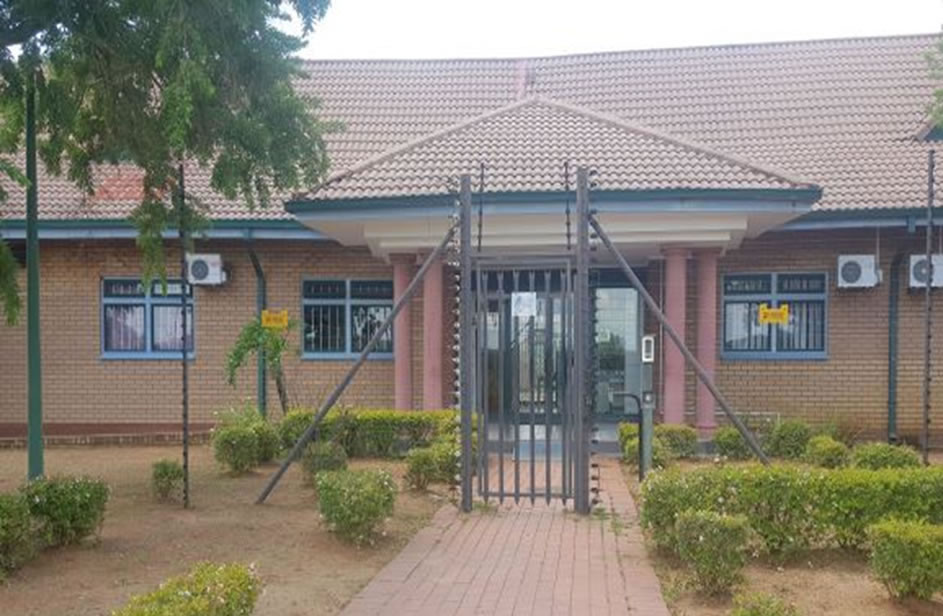 |
Background
South Africa has been an active member of the SADC Plant Genetic Resources Centre (SPGRC) since 1996.
The National Gene Bank of the Directorate: Genetic Resources under the Department of Agriculture, Land Reform and Rural Development (DALRRD) coordinates national activities related to the conservation and sustainable use of plant genetic resources for food and agriculture, which include seed collecting, seed multiplication, characterisation/evaluation/rejuvenation, documentation and gene bank management.
Objectives of the NPGRC:
- Ensure the long-term conservation and sustainable use of PGRFA, including their wild relatives
- Strengthen, promote and support in situ/on-farm and ex situ conservation activities related to the conservation and sustainable use of PGRFA
- Promote access and exchange of PGRFA and the fair and equitable sharing of the benefits arising from their use
- Facilitate the better management and use of PGRFA through improved access to, and exchange of, high quality and up-to-date information
- Strengthen South Africa’s institutions and capacity for implementation of conservation programmes on PGRFA
- Promote and strengthen national, regional and international stakeholder collaboration for the implementation of the National Plan on Conservation and Sustainable Use of PGRFA as well as crop wild relatives (CWR).
Collaboration and organisations/institutions
The NPGRC collaborates with different institutions nationally and internationally, such as Provincial Departments of Agriculture, the Agricultural Research Council (ARC), South African National Biodiversity Institute (SANBI) and Bioversity International.
Activities
Collections
Collections are carried out in collaboration with Agricultural Extension Advisory Services of Provincial Departments of Agriculture, the South African National Biodiversity Institute (SANBI) and ARC. The NPGRC largely collects seed from farmers in different communities. Collection missions mainly target underrepresented species and/or geographical areas. Figure 1 depicts activities undertaken during a collection mission.
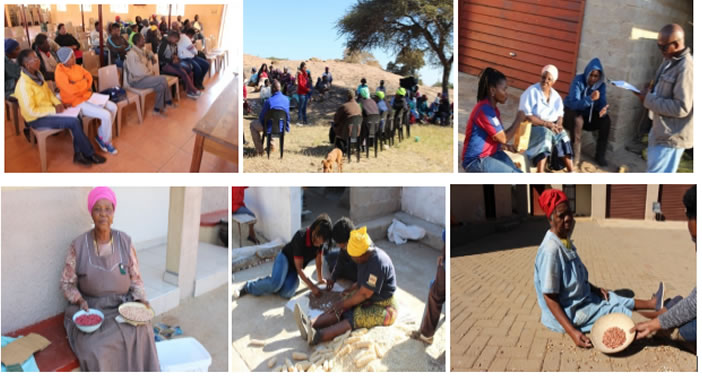
Figure 1: Activities undertaken during a collection mission
Photo Credit: NL Maluleke
Ex situ conservation
The NPGRC houses 6 275 accessions ex situ. The collection constitutes representative of 712 species. Currently, the majority of the accessions belong to: cucurbits (18,5%), beans – cowpeas, Bambara groundnut (16,2%), maize (15%) and sorghum (5%). The NPGRC also houses 284 accessions collected under the SANBI-Millennium Seed Bank Project. These collections are stored in chest freezers (Figure 2) at -18 °C for long-term conservation (base collection). For short-term storage (active collection), a walk-in cold room (Figure 2) maintained at temperatures between 4 °C and 7 °C and a relative humidity of 15% is used. Tissue culture samples are kept in labcons at temperatures between 20 °C and 28 °C. The NPGRC is currently (2021 – 2023) conducting an audit of accessions in the gene bank. Through the audit, it would be possible to identify accessions that have been lost from the ex situ collection. The NPGRC intends to re-collect the lost material.
 |
 |
Figure 2: Base and active collection facilities (walk-in room and freezers)
Photo credit: ML Mokoena
Tissue culture and field gene bank for vegetative crops activities.
The NPGRC maintains three vegetative propagated species, namely, cassava, sweet potato and taro. These three crops are maintained in shade houses (Figure 3). Cassava and sweet potato are also duplicated in tissue culture (Figure 4).
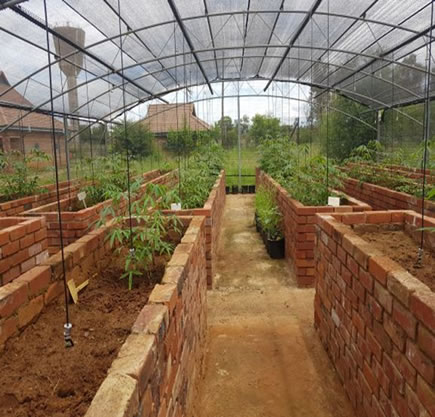 |
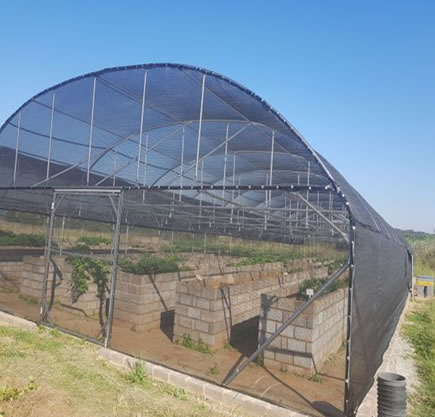 |
Figure 3: Cassava, sweet potato and taro planted in shade houses
Photo credit: ML Mokoena
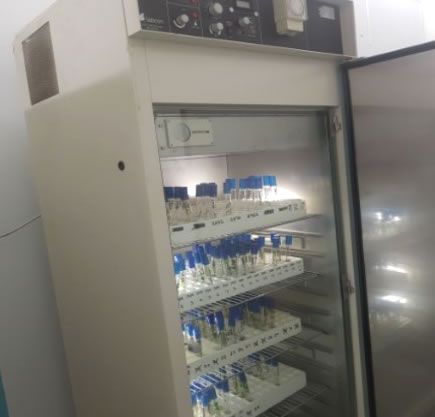 |
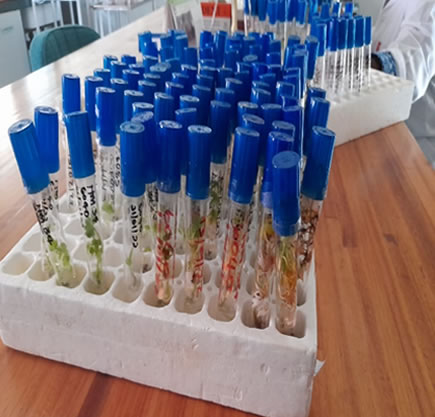 |
Figure 4. Cassava and sweet potato accessions in tissue culture
Photo Credit: MT Manamela
Multiplication and characterisation
The National Plan on Conservation and Sustainable Use of PGRFA identifies gaps and needs for multiplication and characterisation of ex situ accessions. The following crops has been prioritised by the NPGRC for morphological characterisation: Vigna unguiculata (cowpea), Vigna subterranea (Bambara groundnut), Lagenaria siceraria (calabash/bottle gourd), Pennisetum glaucum (pearl millet), Sorghum bicolor (sorghum), Amaranthus sp. (amaranths), Cucurbita pepo (pumpkin), Abelmoschus esculentus (okra) and Colocasia esculenta (taro). Figure 5 depicts characterisation of sorghum at the NPGRC during the 2019/20 growing season. The NPGRC has also requested the SPGRC to multiply certain crops on their behalf, e.g., Vigna subterranea and Arachis hypogaea (peanut).
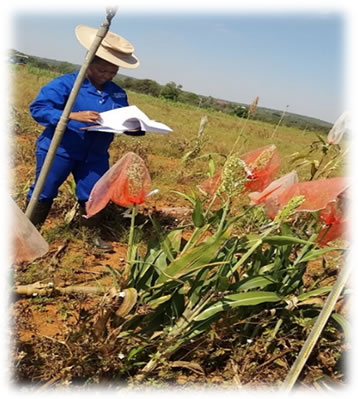 |
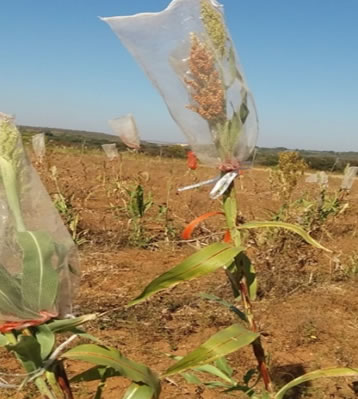 |
Figure 5: Characterisation of sorghum in the field (2019/20)
Photo Credit: MJ Moeaha
Distribution of material
The NPGRC provides access to germplasm maintained ex situ for research purposes to Institutions of Higher Learning and Research Institutions upon signing of a Material Transfer Agreement (MTA). Material is also distributed to local farmers, mainly for repatriation purposes and to replace their lost material.
Documentation
The NPGRC uses the SADC Plant Genetic Resources Centre Documentation Information System (SDIS) to upload and update passport data of accessions and other relevant information. Passport data of about 6 275 accessions has been updated on the SDIS. The NPGRC also annually update accessions’ information of PGRFA through the FAO World Information and Early Warning System (WIEWS).
In situ and on-farm conservation
Community Seed Bank project
From 2013–2019, the department had partnered with Bioversity International in a project aimed at strengthening farmers' seed systems and Community Seed Bank (CSB) Projects in South Africa. This project was funded through contributions made by the Republic of South Africa (acting through the then DAFF) to the Consortium of International Agricultural Research Centres (CGIAR) Trust Fund. So far, through this project, three Community Seed Banks have been established in Gumbu (Limpopo), Sterkspruit (Eastern Cape) and Jericho (North West); two practical handbooks for establishing and supporting Community Seed Banks have been published; traditional seed exchange, learning workshops and training sessions on Community Seed Bank management and on conservation and sustainable use of plant genetic resources for food and agriculture have been conducted for Gumbu, Jericho and Sterkspruit farmers. Figure 6 shows some of the activities undertaken at Gumbu Community Seed Bank.
 |
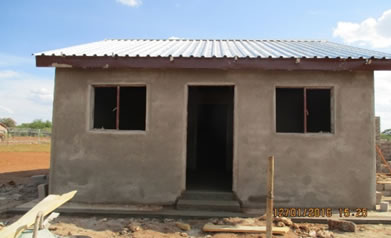 |
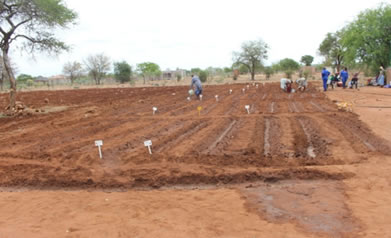 |
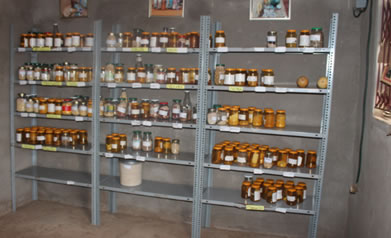 |
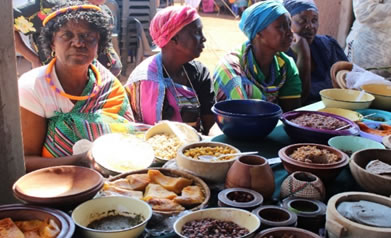 |
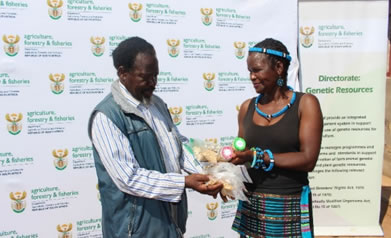 |
Figure 6: Activities undertaken at Gumbu Community Seed Bank
Photo credit: Ronnie Vernooy and ML Mokoena
On-farm conservation projects
To expand on-farm conservation activities of the NPGRC, on-farm conservation and multiplication projects was implemented during 2017 in two provinces, viz., the Free State and Northern Cape. The main aim of the project was to re-introduce varieties that were no longer grown in different areas of the two provinces. Nineteen (19) farmers participated in the project and most were women. To date, about 50 and 29 different crop accessions were planted in the Free State and Northern Cape, respectively (Figure 7). The crops planted included maize, pumpkins, beans, calabash, sorghum, sweet sorghum, cowpea, Bambara, melon and watermelon.
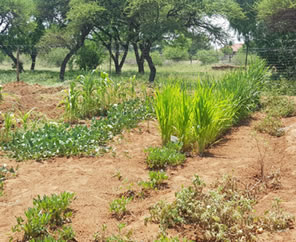 |
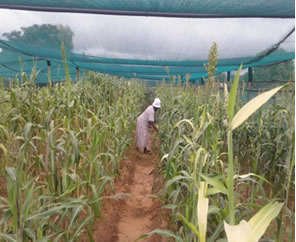 |
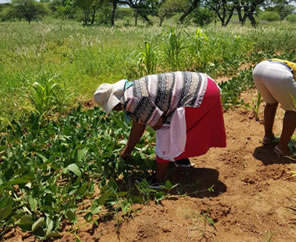 |
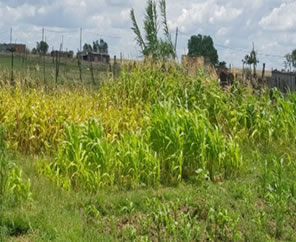 |
Figure 7: On-farm projects in the Free State and Northern Cape (conservation and multiplication plots)
Photo credits: ML Mokoena and RP Sema
Capacity building
In 2019, the NPGRC undertook an exchange visit to Zimbabwe regarding CSBs and Farmers’ Participatory Plant Breeding projects. Zimbabwe was identified as the most suitable country for a fact-finding mission due to similar agro-ecological conditions and their vast experience in the establishment and maintenance of Community Seed Banks. The Community Technology Development Organisation (CTDO) and the Zimbabwe Ministry of Lands, Agriculture, Water and Rural Settlement hosted the DALRRD delegation and a representative from Bioversity International. The main aim was to provide DALRRD officials with the insight on how communities sustain Community Seed Banks beyond the donor-funded projects and to gain a better understanding of the linkages between the roles of the farmers, the National Gene Bank and the research institutions towards the success of Community Seed Banks. The following were the highlights of the fact-finding mission for South Africa to explore:
- The concept of Farmer Field Schools (FFSs), where farmers are trained on activities such as Plant Participatory Breeding (PPB), Participatory Variety Selection (PVS) and Participatory Varietal Enhancement (PVE).
- Nutrition garden programme, which aims to encourage farmers to grow and consume diverse forms of food to ensure a balanced diet and to prevent malnutrition.
- A successful concept in implementing a Community Seed Bank project which involves, and has a close collaboration between, Ministry responsible for Agriculture, the National Gene Bank, Non-Governmental Organisations, Local Government, Research Institutions and Extension Services where resources are shared towards a common goal.
With the knowledge gained from the Zimbabwean fact-finding mission, the NPGRC in collaboration with ARC, relevant Extension Advisory Services and Bioversity International initiated a project on Participatory Plant Breeding involving the three Community Seed Banks in South Africa. Figure 8 shows Farmer Field Schools and a diversity wheel knowledge and skills on an exchange visit from Zimbabwean farmers.
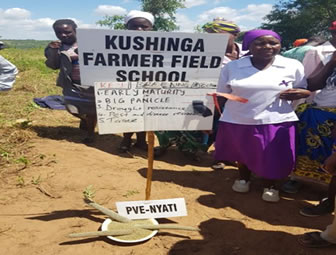 |
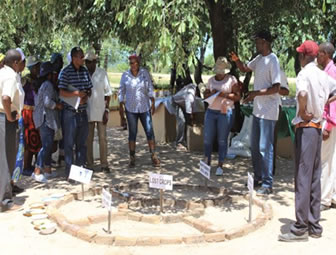 |
Figure 8: Farmer Field Schools and a diversity wheel knowledge and skills on an exchange visit from Zimbabwean farmers
Achievements
- The NPGRC developed the National Plan on Conservation and Sustainable Use of PGRFA (2017), (www.dalrrd.gov.za).
- In collaboration with ARC and SANBI, the NPGRC developed the National Strategic Action Plan for the Conservation and Sustainable Use of Crop Wild Relatives (2017) (www.dalrrd.gov.za).
- The NPGRC developed Standard Operating Procedures (SOPs) and their main objectives are to provide standards for routine gene bank operations.
- In 2021, the NPGRC submitted the Summative Narrative Report: Third Report on the State of Plant Genetic Resources for food and agriculture: South Africa: January 2012 to December 2019,
Publications
The NPGRC together with Bioversity has published several scientific articles, presented on scientific platforms (conferences/congresses/symposiums) and did PGRFA work in South Africa.
- Matelele, L.A., Sema, R.P., Maluleke, N.L., Tjikana, T.T., Mokoena, M.L., Dibiloane, M.A. and Vernooy, R. (2018) Sharing diversity: exchanging seeds and experiences of community seedbanks in South Africa. Bioversity International, Rome, Italy and Department of Agriculture, Forestry and Fisheries, Pretoria, Republic of South Africa. Available at: https://hdl.handle.net/10568/96187
- Vernooy, R., Dibiloane, A., Maluleke, N.L, Matelele, L., Moila, P., Mokoena, M., Phora, P., Sema, P., Sthapit, B., Tjikana, T. (2017) Multiplying diversity: strengthening community seedbanks in South Africa’s smallholder farming areas. Bioversity International, Rome, Italy and Department of Agriculture, Forestry and Fisheries, Pretoria, Republic of South Africa. Available at: https://hdl.handle.net/10568/80543
- Vernooy, R.; Sthapit, B.; Bessette, G. (2017) Community seedbanks: concept and practice. Facilitator handbook. Bioversity International, Rome, Italy; the Department of Agriculture, Forestry and Fisheries, Pretoria, South Africa [Also available in French, Russian and Spanish]. Available at: https://hdl.handle.net/10568/81286
- Vernooy, R., Sthapit, B., Dibiloane, A., Makuleke, N. L., Moila, P., Phora, G., and Tjikana, T. (2017) Implementing a national community seedbank strategy for South Africa. Bioversity International, Rome, Italy, and Department of Agriculture, Forestry and Fisheries, Pretoria, South Africa. Available at: https://hdl.handle.net/10568/80124
- Vernooy, R., Bessette, G., Sthapit, S., Dibiloane, A., Lettie Maluleke, N., Abner Matelele, L., Mokoena, M., Phora, G., Sema, P., Thabo, T. (2018a) How to develop and manage your own community seedbank: Farmers’ handbook. Establishing a community seedbank: Booklet 1 of 3. Bioversity International, Rome, Italy; the Department of Agriculture, Forestry and Fisheries, Pretoria, South Africa [Also available in French and Spanish]. Available at: https://cgspace.cgiar.org/handle/10568/92000
- Vernooy, R., Bessette, G., Sthapit, B., Gupta, A. (2018b) How to develop and manage your own community seedbank: Farmers’ handbook. Technical issues: Booklet 2 of 3. Bioversity International, Rome, Italy; the Department of Agriculture, Forestry and Fisheries, Pretoria, South Africa [Also available in French and Spanish]. Available at: https://cgspace.cgiar.org/handle/10568/92001
- Vernooy, R., Bessette, G., Sthapit, B., Porcuna Ferrer, A. (2018c) How to develop and manage your own community seedbank: Farmers’ handbook. Management, networking, policies and a final checklist: Booklet 3 of 3. Bioversity International, Rome, Italy; the Department of Agriculture, Forestry and Fisheries, Pretoria, South Africa [Also available in French and Spanish]. Available at: https://cgspace.cgiar.org/handle/10568/92002
- Vernooy, R., Netnou-Nkoana, N., Mokoena, M., Sema, R., Tjikana, T., Kasasa, P., Mbozi, H., Mushonga, J., Mushita, A. (2019) Coming together (Batanai): Learning from Zimbabwe’s experiences with community biodiversity conservation, crop improvement and climate change adaptation. Bioversity International, Rome, Italy; Department of Agriculture, Forestry and Fisheries, Pretoria, South Africa; Community Technology Development Organization, Harare, Zimbabwe. Available at: https://hdl.handle.net/10568/10124
- Ronnie Vernooy, Farida Akhter, Sergio Alonzo, Mpolokeng Lydia Mokoena, Andrew Mushita, Gloria Otieno, and Pitambar Shrestha Strengthening Smallholder Farmers’ Capacity to Adapt to Climate Change: Roles of Community Seedbanks: © Springer Nature Switzerland AG 2021 W. Leal Filho et al. (eds.), Handbook of Climate Change Management, https://doi.org/10.1007/978-3-030-22759-3_29-1
- Vernooy, R., Matelele, L.A., Sema, R.P., Mokoena, M.L., Maluleke, N.L., Tjikana, T., Phora, G., Dibiloane, A. (2019). Green shoots. Community seedbanking in South Africa: Endeavours and
outcomes 2016-2019. Bioversity International, Rome, Italy and Department of Agriculture,
Forestry and Fisheries, Pretoria, South Africa.
Conference/Congress proceedings
- Matelele L.A.,P., Sema, N.L, Maluleke, M.L Mokoena & Vernooy R. 2020. Seed flow and diversity assessment of plant genetic resources conserved in two selected community seed banks in South Africa. Presented at the Combined Congress 2020, held from 20th to 23rd January 2020, at the University of the Free State, Bloemfontein, Republic of South Africa. Combined Congress Proceedings page 162.
- Sema R.P, N. Cebekhulu, A. Matelele, M.L. Mokoena, R. Vernooy, M. Bairu, Khoza L. 2020. Assessment of farmers’ interest in participatory plant breeding in Gumbu community seed bank, Limpopo, South Africa. Presented at the Combined Congress 2020, held from 20th to 23rd January 2020, at the University of the Free State, Bloemfontein, Republic of South Africa. Combined Congress Proceedings page 178
- Sema R.P. N.L. Maluleke & Matelele L.A. 2019. Promoting on-farm conservation and multiplication of plant genetic resources in selected provinces of South Africa. Presented at the Combined Congress 2019, held from 21st to 25th January 2019, at the University of the Free State, Bloemfontein, Republic of South Africa. Combined Congress Proceedings, abstract poster 51.
- Mokoena ML., Matelele L.A.,P., Sema, N.L, Maluleke., 2021. Gumbu Community Seed Bank Limpopo Province, South Africa. Presented at the 2ndInternational Agrobiodiversity Congress; role of indigenous people/communities in managing agrobiodiversity under sub theme conservation.
- Moeaha M.J., R.P. Sema, N.L Maluleke., G. Phora. 2018. Workshop on The International Treaty on Plant Genetic Resources for Food and Agriculture (ITPGRFA) in South Africa
- Maluleke N.L, T.T Tjikana, M.L Mokoena, A.M Dibiloane, 2016. IAC 2016, Field Survey of priority Crop Wild Relatives in three provinces of South Africa.
|
Facilities and equipment |
Table 1: The NPGRC infrastructure and laboratory equipment
|
Tissue culture Lab |
Active collection |
Base collection |
Processing Room |
|
1 x laminar flow cabinet 1 x autoclave 2 x upright freezers 1 x liquid nitrogen tank 3 x microscopes 1 x oven 1 x orbital shaker 1 x labcon 1 x liquid nitrogen dewar 1 x pH meter 1 x magnetic stirrer 1 x rotary shaker 1 x water distiller |
Walk-in storage (4 °C) 2 x labcons |
14 new chest freezers procured with 14 data loggers for temperature control (total functional chest freezers: old plus new will be = 22) |
3 x sealers (only one functional) 2 x weighing balance 1 x drying oven 1 x desiccator 1 x seed cleaning machine |
Other equipment and facilities
- Back-up generator for unforeseen circumstances
- Two 4x4 vehicles shared within the Directorate: Genetic Resources
- Farm implements such as tractors and ploughs
NPGRC staff, designation and the contact details
|
Dr NC Netnou-Nkoana |
Director: Genetic Resources |
|
Ms ML Mokoena |
Scientific Manager PGR |
|
Mr TT Tjikana |
Scientist: Production (Curator) |
|
Ms MT Manamela |
Scientist: Production (ex situ) |
|
Ms MJ Moeaha |
Scientist: Production (ex situ) |
|
Mr G Phora |
Scientist: Technician |
|
Mr LA Matelele |
Scientist: Production (in situ/on-farm) |
|
Ms RP Sema |
Scientist: Production (in situ/on-farm) |
|
Ms NL Maluleke |
Collection Officer |
|
Scientific Technician |
Vacant |
Contacts
RSA Plant Genetic Resources Centre
Private Bag X973, PRETORIA 0001, South Africa
Tel: +27 12 319 6428/6431/ +27 60 972 9702
Email: This email address is being protected from spambots. You need JavaScript enabled to view it. (Scientific Manager)
This email address is being protected from spambots. You need JavaScript enabled to view it. (Scientist Production, Curator)

